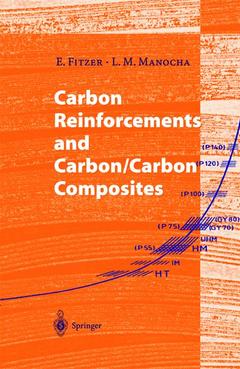Description
Carbon Reinforcements and Carbon/Carbon Composites, Softcover reprint of the original 1st ed. 1998
Authors: Fitzer E., Manocha Lalit M.
Language: French
Subject for Carbon Reinforcements and Carbon/Carbon Composites:
Publication date: 10-2012
344 p. · 15.5x23.5 cm · Paperback
344 p. · 15.5x23.5 cm · Paperback
Description
/li>Contents
/li>Comment
/li>
Advanced composite materials have been a major research focus for the past forty years. As a reinforcement for conventional materials including glass, ceramics and polymers, carbon has proved to be the most successful. Carbon gives these materials flexibility so that they may be produced in bulk form with a wide variety of properties. Whereas carbon/carbon composites are the most effective materials in extreme temperature conditions. Application ranges from brakes to missile nose cones. Carbon Reinforcements and Carbon/Carbon Composites gives the present state on this subject in comprehensive form, as well as projections for other "High Tech" materials and their application.
Reinforcement.- 1 Carbon Fibers.- 1.1 Introduction.- 1.2 Key to the Strength and Stiffness of Carbon Fibers.- 1.3 Short History of Carbon Fiber Development.- 1.3.1 Early High Performance Carbon Fibers.- 1.3.2 Japanese Dominance of Carbon Fiber Market.- 1.4 Carbon Fiber Process.- 1.5 PAN-Based Carbon Fibers.- 1.6 Pitch-Based Carbon Fibers.- 1.6.1 Mesophase Pitches.- 1.6.2 Melt Spinning Mesophase Pitch Precursor Fibers.- 1.6.3 Thermosetting Mesophase Pitch Fibers.- 1.6.4 Carbonization and Graphitization.- 1.7 Vapor-Grown Carbon Fibers.- 1.8 Current Status of Carbon Fibers.- 1.9 Structure of Carbon Fibers.- 1.10 Fracture Behavior of Carbon Fibers.- 1.11 Emerging Carbon Fibers.- 1.11.1 PAN-Based Carbon Fibers.- 1.11.2 Pitched-Based Carbon Fibers.- 1.12 Adhesion of Carbon Fibers.- 1.13 References.- Carbon/Carbon Composites.- 2 Introduction.- 2.1 Carbon/Carbon Composites and Conventional Graphite.- 2.2 References.- 3 Carbon Fiber Architecture.- 3.1 Discrete Fibers.- 3.2 Unidirectional Fibers.- 3.3 Planar (2D) Preforms.- 3.4 Three-Dimensional Preforms.- 3.5 Multidirectional Structures.- 3.6 References.- 4 Processing of Carbon/Carbon Composites.- 4.1 Basic Routes for Fabrication of Carbon Products.- 4.1.1 One-Step Pyrolysis.- 4.1.2 Two-Step Pyrolysis.- 4.1.3 Three-Step Pyrolysis.- 4.1.4 Multistep Pyrolysis.- 4.2 Gas Phase Impregnation Process.- 4.2.1 Isothermal Chemical Vapor Deposition.- 4.2.2 Thermal Gradient Process.- 4.2.3 Differential Pressure Process.- 4.3 Density of CVD Carbon/Carbon Composites.- 4.4 The Classical Fabrication Route, as Used for Carbon Ceramic.- 4.4.1 Impregnating Precursors.- 4.5 Processing of Composites with Thermosetting Resins as Matrix Precursors.- 4.6 Composites with Pitch as Matrix Precursor.- 4.6.1 Standard Process.- 4.6.2 High Pressure Processing.- 4.7 References.- 5 Microstructure of Carbon/Carbon Composites.- 5.1 Microstructure of Carbon Matrix Produced by Chemical Vapor Deposition.- 5.2 Carbon/Carbon Composites Fabrication by the Liquid Infiltration Route.- 5.2.1 Macroscopic Features.- 5.2.2 Matrix Microstructure in Thermosetting-Resin-Derived Carbon/Carbon Composites.- 5.2.3 Matrix Microstructure in Pitch-Derived Carbon/Carbon Composites.- 5.3 Interfaces in Carbon/Carbon Composites.- 5.4 X-ray Diffraction Studies on Carbon/Carbon Composites.- 5.5 References.- 6 Mechanical Properties of Carbon/Carbon Composites.- 6.1 Introduction.- 6.2 Basic Concepts Governing Mechanical Properties of Carbon/Carbon Composites.- 6.2.1 The Young’s Modulus of the Composites.- 6.2.2 Strength of the Composites.- 6.3 Mechanical Properties of Composites with Pyrolytic Carbon Matrix.- 6.4 Carbon/Carbon Composites Fabricated by the Liquid Infiltration Technique.- 6.4.1 Thermosetting-Resin-Derived Carbon/Carbon Composites.- 6.4.2 Pitch-Derived Carbon/Carbon Composites.- 6.4.3 Angle-Plied Composites.- 6.4.4 Sandwich Composites.- 6.5 Fracture Toughness of Carbon/Carbon Composites.- 6.6 Fatigue and Creep Properties.- 6.7 Mechanical Properties at High Temperature.- 6.8 Effect of Oxidation on Mechanical Properties of Carbon/Carbon Composites.- 6.9 Effect of Neutron Irradiation on Properties of Carbon/Carbon Composites.- 6.10 References.- 7 Thermal Properties of Carbon/Carbon Composites.- 7.1 Thermal Transport Phenomena.- 7.2 Carbon/Carbon Composites with Thermosetting Resin-Derived Carbon Matrixes.- 7.3 Composites with Pitch-Derived Matrixes.- 7.4 Composites with Pyrocarbon Matrix.- 7.5 High Conductivity Carbon/Carbon Composites.- 7.6 Thermal Expansion of Composites.- 7.7 Specific Heat of Carbon/Carbon Composites.- 7.8 Thermal Shock Resistance of Carbon/Carbon Composites.- 7.9 References.- 8 Friction and Wear Properties of Carbon/Carbon Composites.- 8.1 Design.- 8.2 Low Energy Tribological Behavior of Carbon/Carbon Composites.- 8.3 References.- 9 Oxidation and Oxidation Protection of Carbon/Carbon Composites.- 9.1 Oxidation of Carbon/Carbon Composites.- 9.2 Protection of Carbon/Carbon Composites Against Oxidation.- 9.2.1 Oxidation Protection by Inhibitors.- 9.2.2 Protection by Coatings.- 9.3 References.- 10 Applications of Carbon/Carbon Composites.- 10.1 Carbon/Carbon Composites as Brake Discs.- 10.2 Carbon/Carbon Materials for the Aerospace Industry.- 10.3 Aeroengine and Turbine Components.- 10.4 Diesel Engine Components.- 10.5 Carbon/Carbon Composites as Refractory Materials.- 10.5.1 Hot Press Dies.- 10.5.2 High Temperature Corrosion Resistant Fasteners.- 10.5.3 Carbon/Carbon Composites in the Glass Industry.- 10.6 Carbon/Carbon Composites for Use at Intermediate Temperatures.- 10.7 Carbon/Carbon Components for Chemical Process Technology.- 10.8 Carbon/Carbon Composites as Bio-compatible Materials.- 10.9 Emerging Applications.- 10.10 References.
First comprehensive overview on the subject
A must for all material scientists particularly those involved in processing
© 2024 LAVOISIER S.A.S.

